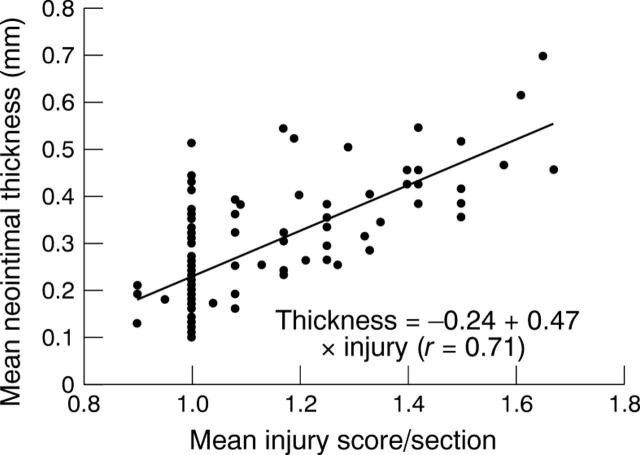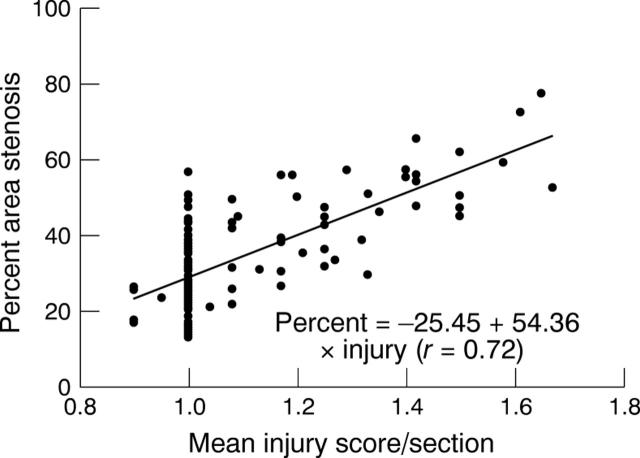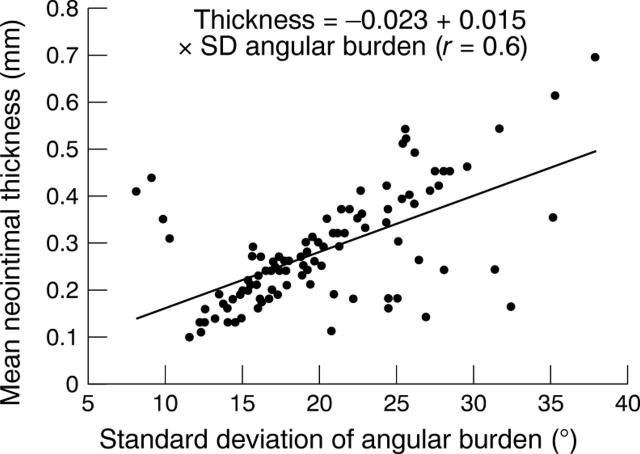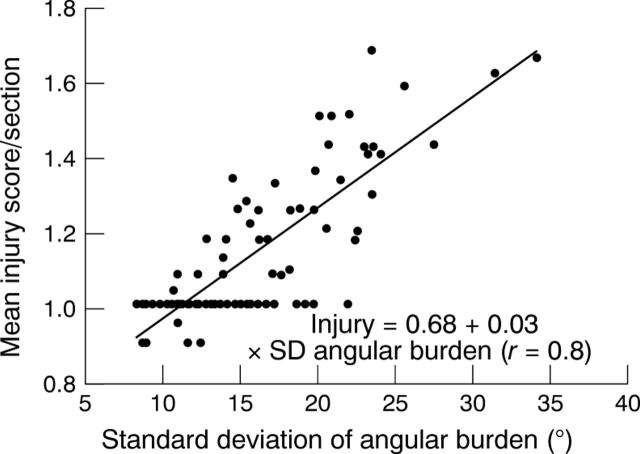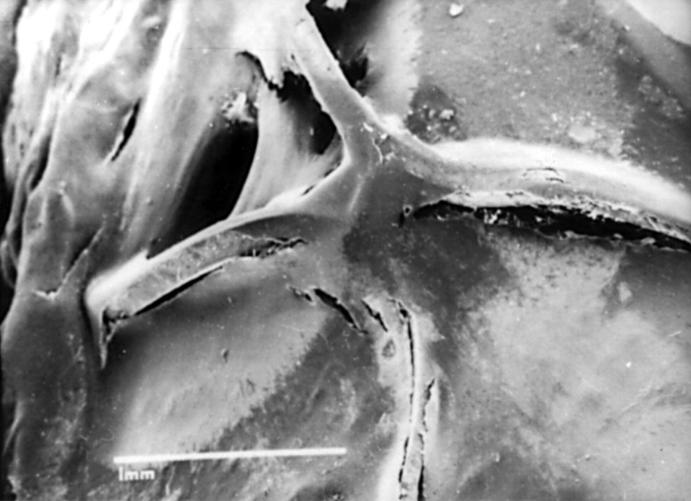Abstract
OBJECTIVE—To assess the impact of stent symmetry on restenosis using the coronary overstretch sheep model. METHODS—Neointimal thickness, injury index, and percentage diameter and area stenosis were calculated by digital morphometry. The standard deviation of the angular burden was used to assess stent symmetry for each section. MATERIALS—15 healthy Merino sheep (63-75 kg) underwent implantation of 30 slotted tube stents (7 mm). Restenosis was induced by calculated overstretch of the coronary artery. Twenty eight days after implantation, stents were excised and underwent histological examination using quantitative digital morphometry. RESULTS—The severity of vessel injury was positively correlated with neointimal thickness and with percentage diameter and area stenosis (p < 0.001). Mean neointimal thickness and mean vascular injury per cross section were strongly related to the standard deviation of angular burden, with correlation coefficients of 0.6 and 0.8, respectively (p < 0.001). CONCLUSIONS—The well known relation between vascular injury and restenosis was confirmed, and a new relation was discovered between stent asymmetry and restenosis. If these results apply to human coronary arteries, restenosis may also be dependent on the degree of asymmetric stent expansion. These results should influence the development of new stent designs to reduce asymmetric stent expansion, leading to a more homogeneous strain distribution in stented coronary segments. Keywords: stent symmetry; vascular injury; restenosis; interventional cardiology
Full Text
The Full Text of this article is available as a PDF (165.8 KB).
Figure 1 .
Scatterplot of mean vascular injury score versus mean neointimal thickness per section. There is a proportional relation. The scatter increases for increasing depth of injury.
Figure 2 .
Scatterplot of mean vascular injury versus percentage area stenosis per section. There is a proportional relation, as in fig 1.
Figure 3 .
Low power photomicrographs from methylmethacrylate embedded sections from sheep coronary arteries 28 days after stent implantation. (Paragon stain, magnification × 14.) Representative cross section with symmetric (A) and asymmetric (B) stent expansion. An eccentric and more pronounced neointima formation is present in (B) which can be attributed to asymmetric stent expansion.
Figure 4 .
Scatterplot of standard deviation of angular burden versus mean neointimal thickness per section. The proportional relation indicates that restenosis is related to asymmetric stent expansion.
Figure 5 .
Scatterplot of standard deviation of angular burden versus average injury score per section. The injury vessel score is related to the standard deviation of the angular burden, showing that asymmetric stent deployment leads to increased vascular injury.
Figure 6 .
Scanning electron microscopy (× 27.5 magnification) showing a strut intersection of a slotted tube stent 28 days after implantation in a sheep coronary artery. Note the badly torqued struts in that area of pronounced stent extension.
Selected References
These references are in PubMed. This may not be the complete list of references from this article.
- Andersen H. R., Maeng M., Thorwest M., Falk E. Remodeling rather than neointimal formation explains luminal narrowing after deep vessel wall injury: insights from a porcine coronary (re)stenosis model. Circulation. 1996 May 1;93(9):1716–1724. doi: 10.1161/01.cir.93.9.1716. [DOI] [PubMed] [Google Scholar]
- Cheng G. C., Briggs W. H., Gerson D. S., Libby P., Grodzinsky A. J., Gray M. L., Lee R. T. Mechanical strain tightly controls fibroblast growth factor-2 release from cultured human vascular smooth muscle cells. Circ Res. 1997 Jan;80(1):28–36. doi: 10.1161/01.res.80.1.28. [DOI] [PubMed] [Google Scholar]
- Cheng G. C., Libby P., Grodzinsky A. J., Lee R. T. Induction of DNA synthesis by a single transient mechanical stimulus of human vascular smooth muscle cells. Role of fibroblast growth factor-2. Circulation. 1996 Jan 1;93(1):99–105. doi: 10.1161/01.cir.93.1.99. [DOI] [PubMed] [Google Scholar]
- Dirschinger J., Kastrati A., Neumann F. J., Boekstegers P., Elezi S., Mehilli J., Schühlen H., Pache J., Alt E., Blasini R. Influence of balloon pressure during stent placement in native coronary arteries on early and late angiographic and clinical outcome: A randomized evaluation of high-pressure inflation. Circulation. 1999 Aug 31;100(9):918–923. doi: 10.1161/01.cir.100.9.918. [DOI] [PubMed] [Google Scholar]
- Dussaillant G. R., Mintz G. S., Pichard A. D., Kent K. M., Satler L. F., Popma J. J., Wong S. C., Leon M. B. Small stent size and intimal hyperplasia contribute to restenosis: a volumetric intravascular ultrasound analysis. J Am Coll Cardiol. 1995 Sep;26(3):720–724. doi: 10.1016/0735-1097(95)00249-4. [DOI] [PubMed] [Google Scholar]
- Ferguson J. J. American College of Cardiology 45th Annual Scientific Session, Orlando, Florida, March 24 to 27, 1996. Circulation. 1996 Jul 1;94(1):1–5. doi: 10.1161/01.cir.94.1.1. [DOI] [PubMed] [Google Scholar]
- Fischman D. L., Leon M. B., Baim D. S., Schatz R. A., Savage M. P., Penn I., Detre K., Veltri L., Ricci D., Nobuyoshi M. A randomized comparison of coronary-stent placement and balloon angioplasty in the treatment of coronary artery disease. Stent Restenosis Study Investigators. N Engl J Med. 1994 Aug 25;331(8):496–501. doi: 10.1056/NEJM199408253310802. [DOI] [PubMed] [Google Scholar]
- Goldberg S. L., Di Mario C., Hall P., Colombo A. Comparison of aggressive versus nonaggressive balloon dilatation for stent deployment on late loss and restenosis in native coronary arteries. Am J Cardiol. 1998 Mar 15;81(6):708–712. doi: 10.1016/s0002-9149(97)01017-5. [DOI] [PubMed] [Google Scholar]
- Gordon P. C., Gibson C. M., Cohen D. J., Carrozza J. P., Kuntz R. E., Baim D. S. Mechanisms of restenosis and redilation within coronary stents--quantitative angiographic assessment. J Am Coll Cardiol. 1993 Apr;21(5):1166–1174. doi: 10.1016/0735-1097(93)90241-r. [DOI] [PubMed] [Google Scholar]
- Grinstead W. C., Rodgers G. P., Mazur W., French B. A., Cromeens D., Van Pelt C., West S. M., Raizner A. E. Comparison of three porcine restenosis models: the relative importance of hypercholesterolemia, endothelial abrasion, and stenting. Coron Artery Dis. 1994 May;5(5):425–434. doi: 10.1097/00019501-199405000-00009. [DOI] [PubMed] [Google Scholar]
- Haude M., Erbel R., Issa H., Meyer J. Quantitative analysis of elastic recoil after balloon angioplasty and after intracoronary implantation of balloon-expandable Palmaz-Schatz stents. J Am Coll Cardiol. 1993 Jan;21(1):26–34. doi: 10.1016/0735-1097(93)90713-b. [DOI] [PubMed] [Google Scholar]
- Hoffmann R., Mintz G. S., Dussaillant G. R., Popma J. J., Pichard A. D., Satler L. F., Kent K. M., Griffin J., Leon M. B. Patterns and mechanisms of in-stent restenosis. A serial intravascular ultrasound study. Circulation. 1996 Sep 15;94(6):1247–1254. doi: 10.1161/01.cir.94.6.1247. [DOI] [PubMed] [Google Scholar]
- Hofma S. H., Whelan D. M., van Beusekom H. M., Verdouw P. D., van der Giessen W. J. Increasing arterial wall injury after long-term implantation of two types of stent in a porcine coronary model. Eur Heart J. 1998 Apr;19(4):601–609. doi: 10.1053/euhj.1997.0753. [DOI] [PubMed] [Google Scholar]
- Holmes D. R., Camrud A. R., Jorgenson M. A., Edwards W. D., Schwartz R. S. Polymeric stenting in the porcine coronary artery model: differential outcome of exogenous fibrin sleeves versus polyurethane-coated stents. J Am Coll Cardiol. 1994 Aug;24(2):525–531. doi: 10.1016/0735-1097(94)90313-1. [DOI] [PubMed] [Google Scholar]
- Ikari Y., Hara K., Tamura T., Saeki F., Yamaguchi T. Luminal loss and site of restenosis after Palmaz-Schatz coronary stent implantation. Am J Cardiol. 1995 Jul 15;76(3):117–120. doi: 10.1016/s0002-9149(99)80041-1. [DOI] [PubMed] [Google Scholar]
- Kastrati A., Schömig A., Elezi S., Schühlen H., Dirschinger J., Hadamitzky M., Wehinger A., Hausleiter J., Walter H., Neumann F. J. Predictive factors of restenosis after coronary stent placement. J Am Coll Cardiol. 1997 Nov 15;30(6):1428–1436. doi: 10.1016/s0735-1097(97)00334-3. [DOI] [PubMed] [Google Scholar]
- Koyama H., Olson N. E., Dastvan F. F., Reidy M. A. Cell replication in the arterial wall: activation of signaling pathway following in vivo injury. Circ Res. 1998 Apr 6;82(6):713–721. doi: 10.1161/01.res.82.6.713. [DOI] [PubMed] [Google Scholar]
- Kranzhöfer A., Baker A. H., George S. J., Newby A. C. Expression of tissue inhibitor of metalloproteinase-1, -2, and -3 during neointima formation in organ cultures of human saphenous vein. Arterioscler Thromb Vasc Biol. 1999 Feb;19(2):255–265. doi: 10.1161/01.atv.19.2.255. [DOI] [PubMed] [Google Scholar]
- Kuntz R. E., Gibson C. M., Nobuyoshi M., Baim D. S. Generalized model of restenosis after conventional balloon angioplasty, stenting and directional atherectomy. J Am Coll Cardiol. 1993 Jan;21(1):15–25. doi: 10.1016/0735-1097(93)90712-a. [DOI] [PubMed] [Google Scholar]
- Kuntz R. E., Safian R. D., Carrozza J. P., Fishman R. F., Mansour M., Baim D. S. The importance of acute luminal diameter in determining restenosis after coronary atherectomy or stenting. Circulation. 1992 Dec;86(6):1827–1835. doi: 10.1161/01.cir.86.6.1827. [DOI] [PubMed] [Google Scholar]
- Nakamura S., Colombo A., Gaglione A., Almagor Y., Goldberg S. L., Maiello L., Finci L., Tobis J. M. Intracoronary ultrasound observations during stent implantation. Circulation. 1994 May;89(5):2026–2034. doi: 10.1161/01.cir.89.5.2026. [DOI] [PubMed] [Google Scholar]
- Narins C. R., Holmes D. R., Jr, Topol E. J. A call for provisional stenting: the balloon is back! Circulation. 1998 Apr 7;97(13):1298–1305. doi: 10.1161/01.cir.97.13.1298. [DOI] [PubMed] [Google Scholar]
- Nikol S., Huehns T. Y., Höfling B. Molecular biology and post-angioplasty restenosis. Atherosclerosis. 1996 Jun;123(1-2):17–31. doi: 10.1016/0021-9150(96)05807-8. [DOI] [PubMed] [Google Scholar]
- Painter J. A., Mintz G. S., Wong S. C., Popma J. J., Pichard A. D., Kent K. M., Satler L. F., Leon M. B. Serial intravascular ultrasound studies fail to show evidence of chronic Palmaz-Schatz stent recoil. Am J Cardiol. 1995 Feb 15;75(5):398–400. doi: 10.1016/s0002-9149(99)80564-5. [DOI] [PubMed] [Google Scholar]
- Rogers C., Edelman E. R. Endovascular stent design dictates experimental restenosis and thrombosis. Circulation. 1995 Jun 15;91(12):2995–3001. doi: 10.1161/01.cir.91.12.2995. [DOI] [PubMed] [Google Scholar]
- Schwartz R. S., Huber K. C., Murphy J. G., Edwards W. D., Camrud A. R., Vlietstra R. E., Holmes D. R. Restenosis and the proportional neointimal response to coronary artery injury: results in a porcine model. J Am Coll Cardiol. 1992 Feb;19(2):267–274. doi: 10.1016/0735-1097(92)90476-4. [DOI] [PubMed] [Google Scholar]
- Serruys P. W., de Jaegere P., Kiemeneij F., Macaya C., Rutsch W., Heyndrickx G., Emanuelsson H., Marco J., Legrand V., Materne P. A comparison of balloon-expandable-stent implantation with balloon angioplasty in patients with coronary artery disease. Benestent Study Group. N Engl J Med. 1994 Aug 25;331(8):489–495. doi: 10.1056/NEJM199408253310801. [DOI] [PubMed] [Google Scholar]
- Thomas WJ, Laird JR, Bailey L, Hoopes TG, Hillhouse R, Scott D, Jones R, Virmani R, Carter AJ. Experimental Results with the Multi-Linkª Stent in a Porcine Model. J Invasive Cardiol. 1997 Sep;9(7):453–460. [PubMed] [Google Scholar]
- Yang J. H., Briggs W. H., Libby P., Lee R. T. Small mechanical strains selectively suppress matrix metalloproteinase-1 expression by human vascular smooth muscle cells. J Biol Chem. 1998 Mar 13;273(11):6550–6555. doi: 10.1074/jbc.273.11.6550. [DOI] [PubMed] [Google Scholar]
- von Birgelen C., Mintz G. S., Nicosia A., Foley D. P., van der Giessen W. J., Bruining N., Airiian S. G., Roelandt J. R., de Feyter P. J., Serruys P. W. Electrocardiogram-gated intravascular ultrasound image acquisition after coronary stent deployment facilitates on-line three-dimensional reconstruction and automated lumen quantification. J Am Coll Cardiol. 1997 Aug;30(2):436–443. doi: 10.1016/s0735-1097(97)00154-x. [DOI] [PubMed] [Google Scholar]



